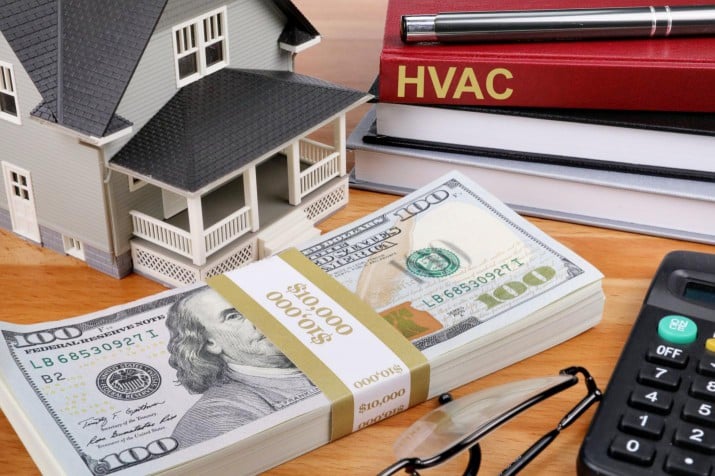Flat rate pricing incorporates a markup or profit, based either on a specific amount or percentage basis, after calculating the direct cost of delivering a service. These amounts are added together to create a single, flat-rate cost.
Flat rate pricing covers direct and indirect costs.
Direct costs are the usual time and materials (T&'M) costs.
Indirect Costs: Travel costs like petrol to go to work, truck wear, uniforms, training, etc.
The way different businesses handle this component may vary, but the result is always the same—your staff can fully calculate the cost of a job. In many aspects, flat rate pricing is similar to T&'M, except that the prices are fixed.
When the flat rate cost of a particular job is accurately calculated, it should result in a sizable profit.
What is Flat Rate Pricing in HVAC?

Heating, Ventilation, and Air Conditioning (HVAC) companies refer to the many methods used to heat, cool, and transport air between the interior and outdoor spaces in residential and commercial structures. The HVAC sector is a booming, expanding industry with annual sales in the billions.
Determining prices is one of the most significant problems that heating and air conditioning firms experience. When it came to pricing HVAC services, time and materials (T&'M) was once a common practice. This approach was effective in its day, but as technology shrunk the globe and allowed customers to compare and research rates independently, they began to ask for an upfront price before signing on for HVAC projects. Some contractors attempted to use rule-of-thumb pricing approaches, such as multiplying materials by two. However, these could lead them to underbid tasks significantly.
A new standard introduced for the HVAC sector is flat rate pricing. HVAC flat rate pricing presents time and material (T&'M) prices for heating and cooling installations and repairs.
Today's homeowners don't completely understand how their home's heating and cooling system functions, and the majority don't care to discover how an HVAC firm determines its pricing. So, they rely on the technicians of the HVAC company to be the experts and provide them with an honest price calculations.
HVAC Flat Rate Pricing Examples
An HVAC flare rate pricing template allocates prices to multiple HVAC services. A list of services with related costs consolidates the payment and repair procedure, ensuring that all parties know the amount of money required upon completion of the task. Transparency in pricing fosters customer trust while relieving employees of the effort of estimating costs.
A template for HVAC flat rate pricing includes:
- HVAC services are categorized by service type
- Prices allocated for each service
- Discounts and additional price reductions
Advantages of Flat Rate Pricing in HVAC

One of the important advantages of flat rate pricing is effectiveness. When estimating the task, HVAC representatives would have to draw out a thorough quote using T&'M pricing that would include every small purchase the company may need. Additionally, many HVAC technicians might not think about the degree of detail necessary for T&'M to perform well. They can erroneously underbid the job by forgetting to account for individual costs.
Performing correct T&'M required time. Comparatively, flat-rate pricing is quick. Moreover, many HVAC customers criticized the time and money approach. Flat rate pricing enhances consumer satisfaction in this manner. Despite their best efforts, HVAC service technicians may not realize that a part's price has increased or may miscalculate pricing for another reason. They may omit items from the estimate as well. This makes HVAC customers angry because the bill ultimately costs more than anticipated. Flat rate pricing stops this from happening.
Additionally, HVAC customers can evaluate the value of their interaction based on the assistance they receive from the company staff. The challenge of accounting comes last. The billing cycle might go more quickly when it takes lesser time to write service quotes. HVAC may ask clients for deposits before the job starts or divide its invoice to get paid as soon as possible.
Disadvantages of Flat Rate Pricing in HVAC
The biggest disadvantage of flat rate pricing in HVAC is approximate.
Sometimes the task takes longer than expected because HVAC technicians simply don't have as much knowledge of a particular system. Additionally, HVAC may discover that the cost of an item increases significantly, forcing the company to absorb that cost or make the customers pay the cost with the risk of losing them permanently. In both cases, there is a chance that the flat rate pricing HVAC offers won't be sufficient to cover the company's expenses.
Another challenge for flare rate pricing in HVAC is the customization issue. What happens when your customer requests something somewhat different? You can add maintenance services and other extras to the cost of the HVAC company's services, and that can work out extremely nicely for you. It can charge you more for extra services, but subtracting from the flat rates you set can be more challenging.
Using Flat Rate Pricing in HVAC
There are various strategies for setting a flat pricing rate in HVAC. One method is to determine your pricing decisions based on the level of your industry experience. This approach can be effective, but you would need to find out if your prices are much higher or lower than those of other businesses in the neighborhood. Also, look at the pricing that your rivals promote. Unfortunately, that could put you in a price war, and it's unlikely that you'll obtain precise pricing data on anything your competitors offer.
Many HVAC service providers determine their prices using third-party businesses to address these problems. Based on the scope of the job and market rates in your area, these companies publish reasonable market pricing for various air conditioning and heating services. To streamline your price strategy and guarantee that your services are appropriate, you can purchase flat-rate pricing lists from these businesses.






